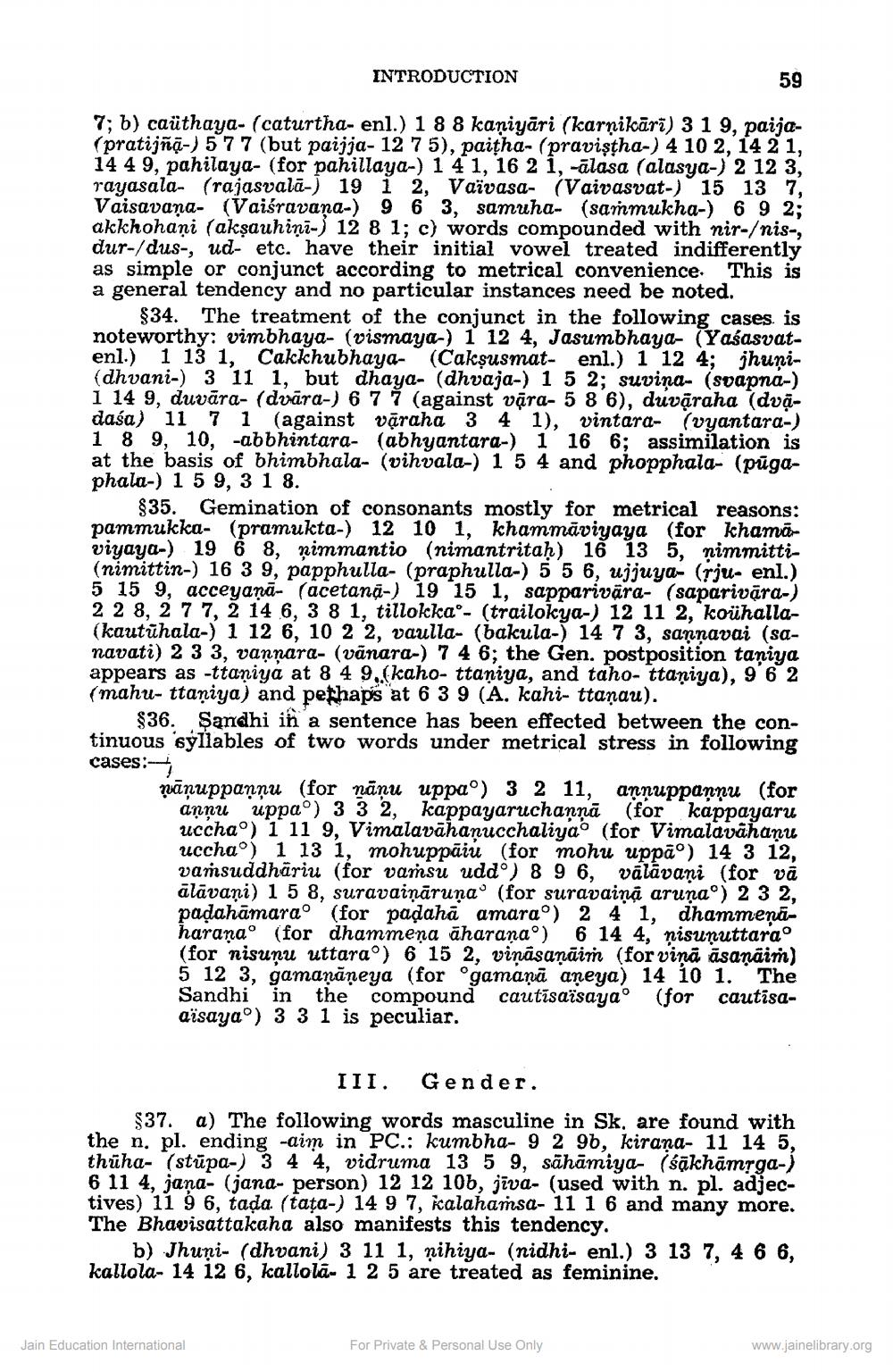________________
INTRODUCTION
59
7; b) caüthaya- (caturtha-enl.) 1 8 8 kaniyāri (karnikāri) 3 1 9, paija(pratijña-) 57 7 (but paijja- 12 75), paitha- (praviştha-) 4 10 2, 14 2 1, 14 4 9, pahilaya- (for pahillaya-) 1 41, 16 2 1, -ālasa (alasya-) 2 12 3, rayasala- (rajasvalā-) 19 i 2, Vaivasa- (Vaivasvat-) 15 13 7, Vaisavana- (Vaiśravana-) 9 6 3, samuha- (sammukha-) 6 9 2; akkhohani (akşauhini-) 12 8 1; c) words compounded with nir-/nis-, dur-/dus-, ud- etc. have their initial vowel treated indifferently as simple or conjunct according to metrical convenience. This is a general tendency and no particular instances need be noted.
$34. The treatment of the conjunct in the following cases, is noteworthy: vimbhaya- (vismaya-) 1 12 4, Jasumbhaya- (Yaśasvatenl.) 1 13 1, Cakkhubhaya- (Caksusmat- enl.) 1 12 4; jhuni(dhvani-) 3 11 1, but dhaya- (dhvaja-) 1 5 2; suviņa- (svapna-) 1 14 9, duvara- (dvāra-) 6 7 7 (against vara- 5 8 6), duväraha (dvadaśa) 11 7 1 (against väraha 3 4 1), vintara-(vyantara-) 1 8 9, 10, -abbhintara- (abhyantara-) 1 16 6; assimilation is at the basis of bhimbhala- (vihvala-) 1 5 4 and phopphala- (pūgaphala-) 1 5 9, 31 8.
$35. Gemination of consonants mostly for metrical reasons: pammukka- (pramukta-) 12 10 1, khammaviyaya (for khamar viyaya-) 19 6 8, nimmantio (nimantritah) 16 13 5, nimmitti(nimittin-) 16 3 9, papphulla- (praphulla-) 5 5 6, ujjuya- (rju- enl.) 5 15 9, acceyaņā- (acetanā-) 19 15 1, sapparivära- (saparivara-) 2 2 8, 2 7 7, 2 14 6 3 8 1, tillokka'- (trailokya-) 12 11 2, koühalla(kautūhala-) 1 12 6, 10 2 2, vaulla- (bakula-) 14 7 3, sannavai (sanavati) 2 3 3, vannara- (vānara-) 7 4 6; the Gen. postposition taniya appears as -ttaniya at 8 4 9..(kaho- ttaniya, and taho- ttaniya), 9 6 2 (mahu- ttaņiya) and perhaps at 6 3 9 (A. kahi- ttanau).
$36. Sandhi in a sentence has been effected between the continuous syllables of two words under metrical stress in following cases:
pāņuppanņu (for nāņu uppa°) 3 2 11, annuppannu (for
annu uppa°) 3 3 2, kappayaruchanņā (for kappayaru ucchao) 1 11 9, Vimalavāhanucchaliya(for Vimalavähanu ucchao) 1 13 1, mohuppāiu (formohu uppao) 14 3 12, vamsuddhāriu (for vansu uddo) 89 6, vālāvani (for vā alāvani) 1 5 8, suravaiņāruņa" (for suravaiņa aruna") 2 3 2, padahāmarao (for padaha amara°) 2 4 1, dhammeņaharanao (for dhammeņa āharanao) 6 14 4, nisunuttara (for nisuņu uttara°) 6 15 2, vināsaņāim (for vinā āsaņāim) 5 12 3, gamaņāņeya (for 'gamaņā aneya) 14 10 1. The Sandhi in the compound cautīsaïsayao (for cautisaaisaya") 3 3 1 is peculiar.
III. Gender.
$37. a) The following words masculine in Sk, are found with the n. pl. ending -aim in PC.: kumbha- 9 2 9b, kirana- 11 14 5, thūha- (stūpa-) 3 4 4, vidruma 13 5 9, sāhāmiya- (sākhāmrga6 11 4, jana- (jana- person) 12 12 10b, jiva- (used with n. pl. adjectives) 11 g 6, tada (tata-) 14 9 7, kalahamsa- 11 1 6 and many more. The Bhavisattakaha also manifests this tendency.
b) Jhuni. (dhvani) 3 11 1. nihiva- (nidhi- enl.) 3 13 7 4 6 6. kallola- 14 12 6, kallolā- 1 2 5 are treated as feminine.
Jain Education International
For Private & Personal Use Only
www.jainelibrary.org




